Disclosure: Meeple Mountain received a free copy of this product in exchange for an honest, unbiased review. This review is not intended to be an endorsement.
A Brief History of Pentominoes
If you take five identical squares and arrange them in different 2D shapes, you’ll end up with 18 different shapes. Twelve of these look the same regardless as to how you orient them, while six can be flipped over to create a mirror image of themselves. Choose one each of the mirrored image shapes and add them to the twelve others and you’ll have what is known as a set of Pentominoes.
Puzzles featuring pentominoes date back to 1907 when Henry Dudeney published a book of mathematical puzzles called The Canterbury Puzzles. In 1960s they gained popularity due to a combination of a book by Simon Golomb (who came up with the name pentominoes) titled Polyominoes: Puzzles, Patterns, Problems, and Packings and a column by Martin Gardner on Mathematical Games in Scientific America.
Even if you’ve never seen Pentominoes before, they might look vaguely familiar. Back in the mid-80s, a Soviet software engineer created an early video game using only four squares. These shapes, known as Tetrominoes, became the cascading shapes of one of the best-selling video games of all time: Tetris.
Sets of 3D pentominoes have been sold throughout the years. Many feature a variety of games and/or puzzles. Recently, Gigamic created their own wooden version of the pentominoes and published a series of puzzles in a package they call Katamino.
What’s In the Box?
Along with a large, full color booklet, the star of Katamino is the brightly colored set of wooden pentominoes all set in a wooden frame.
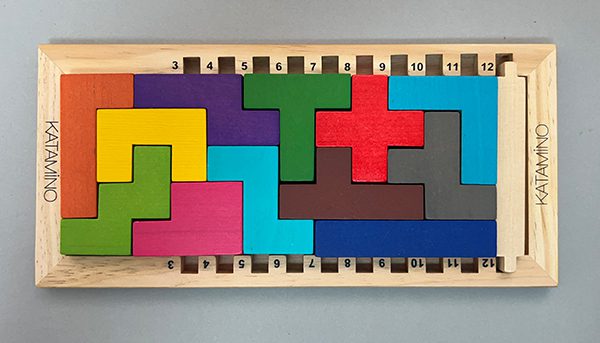
The frame for Katamino is a 5×12 grid. All 12 pieces fit into this grid nicely. (In over 4000 combinations, as it turns out.)
To play, set all the pieces to one side and open the booklet to the back pages. There you’ll find over 500 different puzzle combinations.
Each row of challenges starts off with a specific set of pentominoes. Set aside the other pentominoes and move the wooden bar from its position to the right of 12 to the number of pieces being used.
The introductory challenges start with a set of three pieces. After you’ve used those pieces to create a 3×5 grid, you’ll add a new, specific piece and move the wooden bar down to the 4 slot.
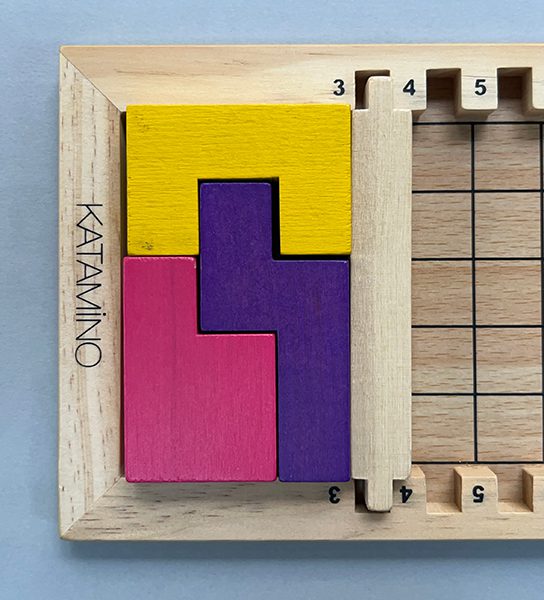
Take, for example, this simple three-piece puzzle
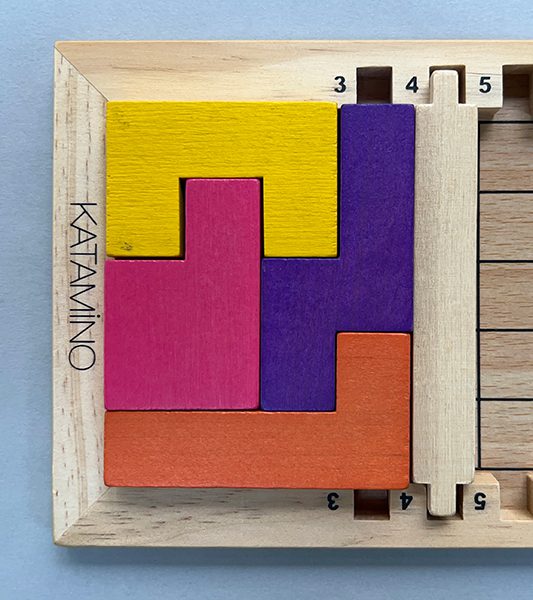
Move the bar from 3 to 4 and add in the piece called for and solve.

Then do the same again with a fifth piece.
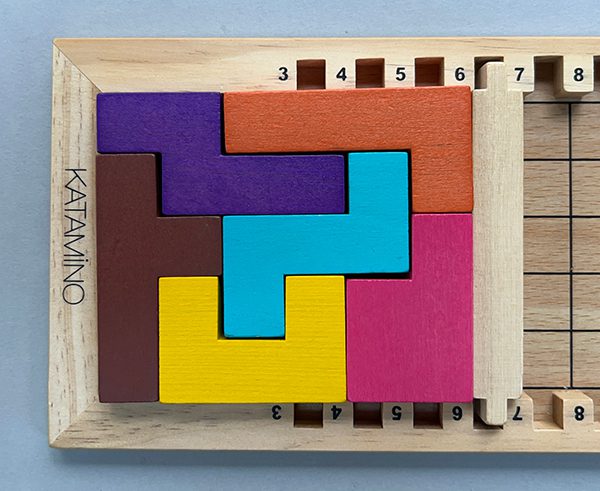
And again with a sixth piece—and then continue.
Intermediate puzzles start with five pieces and advanced puzzles start with seven or nine pieces.
But Is Katamino a Game?

When considering Katamino, I am reminded of the two MazeScape puzzles I reviewed last year. They were unique, clever puzzles that I enjoyed working on over the course of a few weeks. Those, however, were strictly puzzles. What about Katamino?
To its credit, Katamino does include the rules for a single game. The back cover of the booklet is an 8×8 grid for an unnamed game that’s mentioned in a lone paragraph of the text. This game, known in pentomino circles as Golomb’s Game, has players choosing a pentomino and placing it on the board such that all of the parts of the pentomino line up with the grids and it remains within the boundaries of the playing area. The first player who cannot place a piece legally, loses the game.
This sole game really doesn’t do much to change the fact that Katamino is really presented as a series of 2D puzzles, each set within a 5x grid.
Gigamic’s website for Katamino includes all the puzzles included in the booklet. They also have a Teacher’s Guide for teaching pentominoes in the classroom.
Final Thoughts
Games featuring polyominoes have gained in popularity in recent years. Patchwork was one of the first to catch my eye, but there have been a great many others like New York Zoo, A Feast for Odin, The Isle of Cats, Ubongo!, and My City. My fellow Meeple Mountaineer, David McMillian even penned a polyomino Step Ladder article a few years ago.
Polyominoes can be used to help teach young children spatial thinking, an important part of early math education, as well as higher order thinking skills. And what better way to start than with a series of puzzles?
The pieces themselves are made of a lightweight wood. They don’t appear to be carefully cut, however, as I noticed gaps between several of the pieces when they are aligned with each other.
The pieces are painted in bright, kid-friendly colors. The frame is solid, with a grid painted onto the bottom to help you count/visualize the number of squares needed to be filled.
Katamino reminds me of the kind of puzzle my mother would have bought for me when I was a kid. Always looking for things to occupy my puzzle-hungry mind (and keep me quiet for long stretches of time), this would have been exactly the kind of thing I would have loved. As it is, recently I have been drawn back to Katamino whenever I had a spare 10-15 minutes before dinner.
If you enjoy puzzles or have/know kids who do, Katamino is a good entry into the pentominoes and their puzzle-y possibilities.


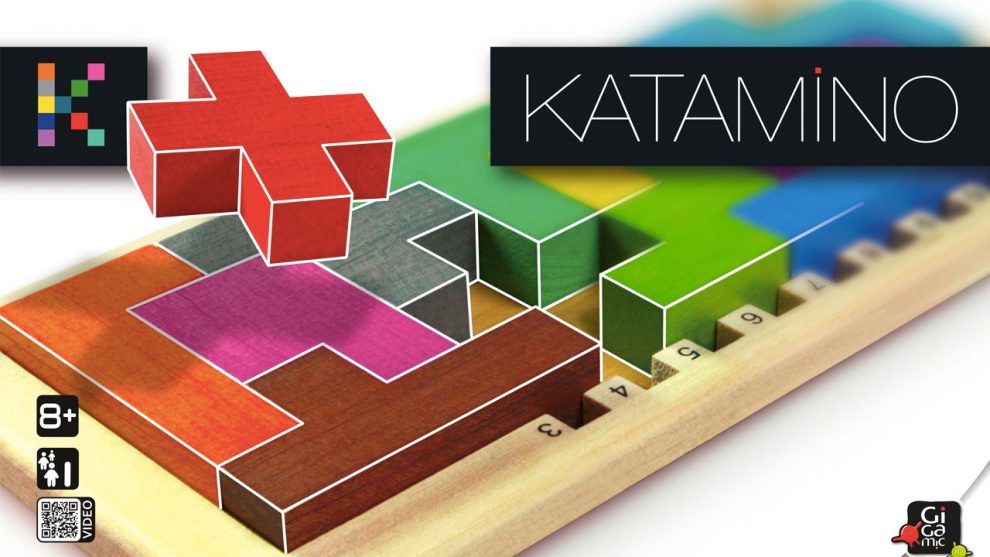

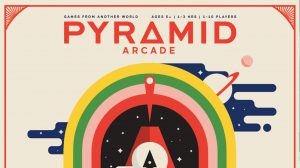

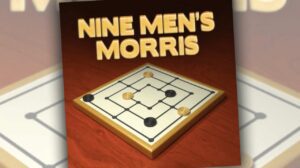





Add Comment